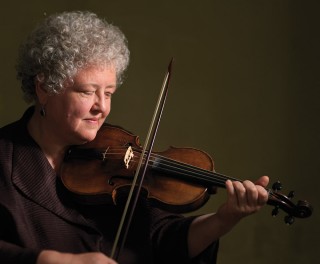Title

Monica Huggett
(Photo by Hiroshi Iwaya)Felix Mendelssohn (1809-47) came from a family that had a lot of connections to the musical world of the 18th century. His aunt Sarah Levy was a pupil of Wilhelm Friedemann Bach, Johann Sebastian's eldest son, and when it was realized that Mendelssohn had prodigious talent, Levy recommended that he study with Carl Friedrich Zelter. Zelter's teaching technique was steeped in Baroque style, which he passed on to his prodigious student and which had a huge influence on Mendelssohn's compositions, particularly the youthful efforts. In these pieces you hear a lot of Baroque gestures and structures—fugues, counterpoint, recitative, and rhetorical figures.
Body
It's no accident that disciples of historical performance are interested in Mendelssohn. For one thing, he was the reason for the revival of the interest in Bach. His grandmother Bella Salomon gave him the score of the all-but-forgotten Bach's St. Matthew Passion, and in 1829, he conducted the first performance of it in something like 100 years. In his lifetime Mendelssohn was considered a conservative composer—Liszt was somewhat his antithesis—but like Brahms would be, he was a Romantic composer whose compositions incorporate Baroque idioms.
Mendelssohn is a natural composer to pair with Mozart, not just because of their shared youthful genius, but because there is a lightness and clarity about his compositions that's very similar to Mozart's. There doesn't seem to be any Mozart that is clouded by extraneous notes—everything has a function; it's really clear. Symphony No. 40 (1788), which we're playing on the second half of this program, can be played as chamber music—it's so well written and it unfolds in such a way that it doesn't need interpreting beyond what a bunch of really good musicians can do. All Mozart's orchestra writing is a joy to play; he used the natural sound and techniques of each specific instrument. That time-honored tradition changed in the 19th century. Composers like Beethoven were pianists, which had a huge effect on how they composed for orchestra: suddenly orchestral music was written as if the orchestra were a huge keyboard, with much less attention to what made each instrument sound good. That generally means the parts are less rewarding to play. From personal experience I can say playing the violin part of Missa Solemnis is misery because it is so unidiomatic for a string instrument. Mendelssohn, however, bucked this trend and wrote idiomatic string music, as Mozart had.
The concert starts with a dramatic opening: the Sinfoniesatz (String Symphony No. 13 in C Minor), which Mendelssohn composed in 1823, when he was 14. The year before, his family had started having salon concerts for the wealthy elite of Berlin, and Mendelssohn's father essentially gave him a string orchestra to compose for. The Sinfoniesatz seems very reminiscent of the Mozart Adagio and Fugue (originally for two keyboards, then transcribed by Mozart for string orchestra). Both pieces are in C minor, and use the almost melodramatic French Baroque style to open, with jagged rhythms, chromaticism, and many trills. The movement that follows is fugal in character and very fast and brilliant, like the last movement of the octet.
The little Violin Concerto in D Minor (1822) that we'll play has been unfairly ignored until now. As with all the great 19th-century concertos, it has a serious first movement, a lighter second movement, and a gypsy- influenced third movement. If you are trained as a modern violinist, you might think it has no substance, but if you have an historical background, you can see it as an 18th-century violin concerto with early Romantic harmony. As the artistic director of two Baroque orchestras, I am always looking for pieces that can be done with small forces. This “Romantic” violin concerto that can be done with string orchestra—that's great. And the first half of the concert will have a brilliant, very virtuoso ending with the E-flat Major String Symphony No. 6, which Mendelssohn composed when he was 12.




